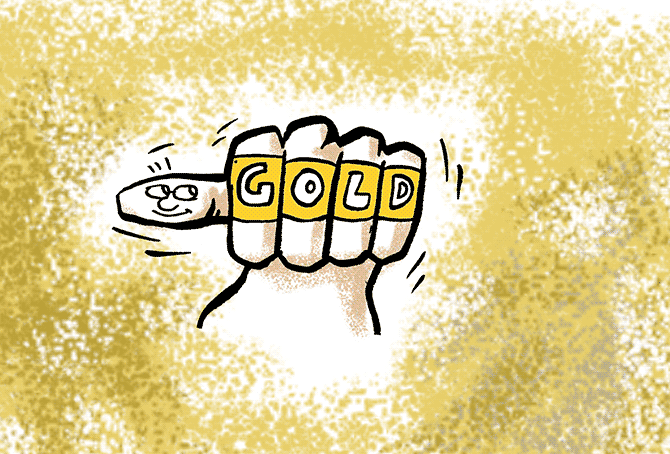In domestic market, gold prices had peaked to Rs 39,011 per 10 grams in September and are now ruling at Rs 38,800 per 10 gram.
Illustration: Dominic Xavier/Rediff.com

India's gold demand slumped 32 per cent to 123.9 tonnes in the September quarter as higher prices and economic slowdown reduced the appetite for the yellow metal, according to a report.
The country, which is the second largest consumer of the yellow metal after China, recorded a 66 per cent fall in gold imports to 80.5 tonnes during Q3 of 2019 against the year-ago period.
The decline in import was steeper as jewellers met their demand with old imported stock and recycling, the Gold Council (WGC) said on Tuesday.
In domestic market, gold prices had peaked to Rs 39,011 per 10 grams in September and are now ruling at Rs 38,800 per 10 gram.
During the first nine months of 2019, the country's cumulative gold demand declined to 496.11 tonnes from 523.9 tonnes during January-September period of 2018.
The 2018 full year gold demand stood at 760.4 tonnes, the report said.
Similarly, the cumulative gold import declined to 502.9 tonnes in the first nine months of 2019 from 587.3 tonnes in the year-ago.
During the full year of 2018, India's gold imports had stood at 755.7 tonnes.
"In India, there was decline in gold demand due to two reasons.
“One was sharp increase in prices by 20 per cent towards the end of Q2 and in Q3.
“The second reason was that, in various countries including India and China, general economic slowdown affected the consumer sentiment," industry group WGC India managing director Somasundaram PR told PTI.
Gold demand fell 32.3 per cent to 123.9 tonnes (including jewellery demand of 101.6 tonnes and bar/coin demand of 22.3 tonnes) during Q3 of 2019 when compared with 183.2 tonnes in the same quarter 2018, he said after releasing the report.
Stating that gold imports too fell due to high prices and lower rural demand, Somasundaram explained, "When demand is low, people recycle gold. Recycled gold in India rose to 90.5 tonnes in the first nine months of this year, as against 87 tonnes during the full year of 2018.
“This is going to be one of the highest years of recycling."
He also pointed out that the domestic gold market went into a deep discount due to poor demand in Q3. "Gold was sold at a discounted price of up to $ 45 per ounce, but the rate later came down to USD 2 per ounce during Diwali."
The other reason for lower imports, according to Somasundaram, was that traders were destocking.
"Since Q1 2017, we have seen imports have been higher than demand.
“There has been a build up stock of 200-220 tonnes.
“When slowdown happens, normally people tend to destock," he said.
Going forward in Q4, the WGC India chief said that high prices of gold will continue, but it would take still longer time for consumers to get used to such rates.
"In terms of consumer sentiments, I don't think things have improved a lot because rural anxiety still continues.
“While demand increased during Diwali and Dhanteras, we don't think it will be better than last year," he said.
Some wedding buying will happen and it is picking. It will not be higher than last year because high prices, he said.
Given this context, Somasundaram said the WGC has revised India's total gold demand estimate downward to 700-750 tonnes for 2019 from its earlier projection of 750-800 tonnes.
"More likely, gold demand would be at the lower end of the range in 2019. It will be one of the low demand years.
“Last time, we saw such a low figure was 667 tonnes in 2016," he added.
Stating that gold imports are likely to be "mute and very low" in 2019, Somasundaram said India's gold import will generally mirror the demand. It will not be high as recycling will continue to remain high because of high prices.
The country's gold import declined to 80.5 tonnes in Q3 of this year from 236.8 tonnes in the same quarter 2018, he added.
According to the WGC report, the world gold demand, however, rose to 1,107.9 tonnes during Q3 of 2019 from 1,079 tonnes in the year-ago despite fall in growth in China and India - the world's two largest consumers of the yellow metal.











 © 2025
© 2025